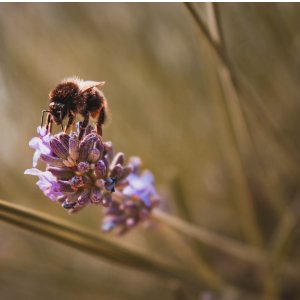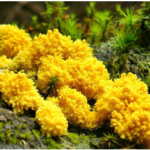Reproduction of plants and animals
- Reproduction of plants and animals is different in various species. Additionally, there are different variations of the breeding systems in these kingdoms.
Bee on a purple colour flower
- Plant and animals have different reproductive structures. In both these kingdoms, the reproductive systems are sub-dividing along with various species. Understanding these varieties of breeding systems can aid in discerning the rearing of animals and plant species for human use to produce higher quality yields and increase the population of extinct and endangered species.
- From the germination of a seed until the complete development of a plant (vegetative phase) and from the birth of a young animal, there are three phases of growth; juvenile, reproductive and senescent phases. The juvenile phase is between growing after birth until the plant reaches sexual maturity and is ready to reproduce.
- Once it comes to the reproductive phase, the organisms become sexually active and reproduce. Finally, when the organism loses its reproductive function, it reaches a senescent stage. These three phases complete an entire circle of life of an organism.
Reproduction in Plants
- In plants, flowers contain either male and female reproductive structures or both, also described as staminate (plants having only stamens) and pistillate (plants having only pistils), respectively. The male reproductive system called stamen consists of an anther and a filament that supports the anther.
- The anther contains pollen grains in its pollen sac. These pollen grains hold single-celled two male gametes. When the anthers reach their maturity, they break open to release the pollen grains. As these pollens are mobile, they fall into the stigma of the female part. The female reproductive organ is the pistil, consisting of an ovary, style, and a stigma.
- The pollen grain sticks onto the stigma (a sticky part), releasing the two male gametes. These male gametes travel through the pollen tube formed inside the style (stalk that supports stigma) and reach the ovary. The ovary encompasses ovules containing female gametes (egg cells).
Bee carrying pollens and feeding on orange flower,
- Once the male gamete reaches the ovary, it fuses with the female gamete; this process is called syngamy. After fusion, fertilisation occurs, forming a zygote, where the cells multiply to form an embryo (early stage of fetal development) in the ovule, transforming into a seed.
- Finally, the plant will lose its petals and sepals while the ovary develops into a fruit. The pericarp is the covering of fruit that encloses the seed formed from the ovary wall. While this fruit contains seed-containing embryos, when planted in the soil will germinate into a new plant.
- Transferring male gametes to female gametes either in the same flower or in different flowers is called pollination. When the pollen grains land on the same flower’s stigma, this is self-pollination, while when the pollen falls into the stigma of a different flower, this is cross-pollination.
- The pollination is carried out by some agents known as pollinators, such as wind, animals (like bees, hummingbirds, butterflies, honey possums, etc.), and water; since they act as a medium for transferring pollen grains to the stigma.
Different Types of Plants
- Monoecious are imperfect plants with separate male and female flowers in the same plant (corn, squash, etc.). While dioecious are imperfect plants, male and female flowers are in separate plants but must be nearby for successful cross-pollination (e.g., date palm, pistachio, etc.).
- Monoecious and dioecious flowers are found to be unisexual. These flowers contain either a male or a female but not both (e.g., watermelon, corn, etc.). Whereas bisexual plants have flowers of male and female reproductive organs (e.g., hibiscus, rose, etc.), leading to self-pollination.
- Additionally, hermaphrodite plants are bisexual plants such as mangoes, daffodils, etc. Since these plants can undergo self-pollination, they do not require pollinators to assist in pollination.
- Unlike the reproductive structures in plants that are differentiated between unisexual and bisexual plants, the reproductive systems of the algae and fungi are distinguished by homothallic and heterothallic. Homothallic is a condition where both male and female organs are contained in the thallus (e.g., Allomyces javanicus).
- Therefore, homothallic plants are bisexual organisms that undergo self-pollination. In contrast, heterothallic plants include male and female reproductive structures in different thalli. Consequently, they are unisexual organisms that reproduce by cross-pollination (e.g., Aspergillus fumigatus).
- Cell division Meiosis is the first process in cell division that reduces the number of chromosomes by half, producing four haploid cells. Meiocytes are the cells that undergo meiosis to give rise to gametes (e.g., maize. potato, etc.). A haploid organism has a single set of chromosomes observed in asexual organisms, such as egg and sperm cells; each is a haploid cell.
- When the male and female gametes fuse by syngamy i.e., two haploid cells combine to form diploid cells to produce a zygote. Diploids are organisms that contain two sets of chromosomes obtained one from each parent and are therefore observed in sexual organisms (e.g., skin, muscle cells, etc.).
Reproduction in Animals
Close-up of bird’s nest containing eggs
- The syngamy of male sperm cells and female egg cells causes fertilisation where these cells, once fused into a zygote, will start multiplying, becoming a blastocyst. These blastocyst cells are further multiplied to transform into an embryo. The embryo is developed into a young organism and is ejected from the female organism.
- The animals are differentiated based on reproductive methods, such as oviparous, viviparous, and ovoviviparous. Oviparous are animals that lay eggs later hatching into young ones (e.g., hens, ducks, etc.). Whereas viviparous animals give birth to young animals as live beings, these animals are called mammals except for platypus and echidnas that lay eggs (e.g., cows, apes, etc.).
- Ovoviviparous are animals that develop eggs and hatch inside the female body. These hatchlings remain inside the female and develop further after nurturing, finally giving birth to live young animals (e.g., sharks, fishes, etc.).
- The difference between oviparous and ovoviviparous animals is that the young oviparous animals get nourished from the yolk inside the egg, while ovoviviparous animals obtain nourishment from the mother.
internal links:
You should know everything before going to Estrous cycle -Erakina
26/04/2022
Tags:
life scienceOther Articles
Next
April 28, 2022
Fungus yellow: the deathly hallow-Erakina
Previous









